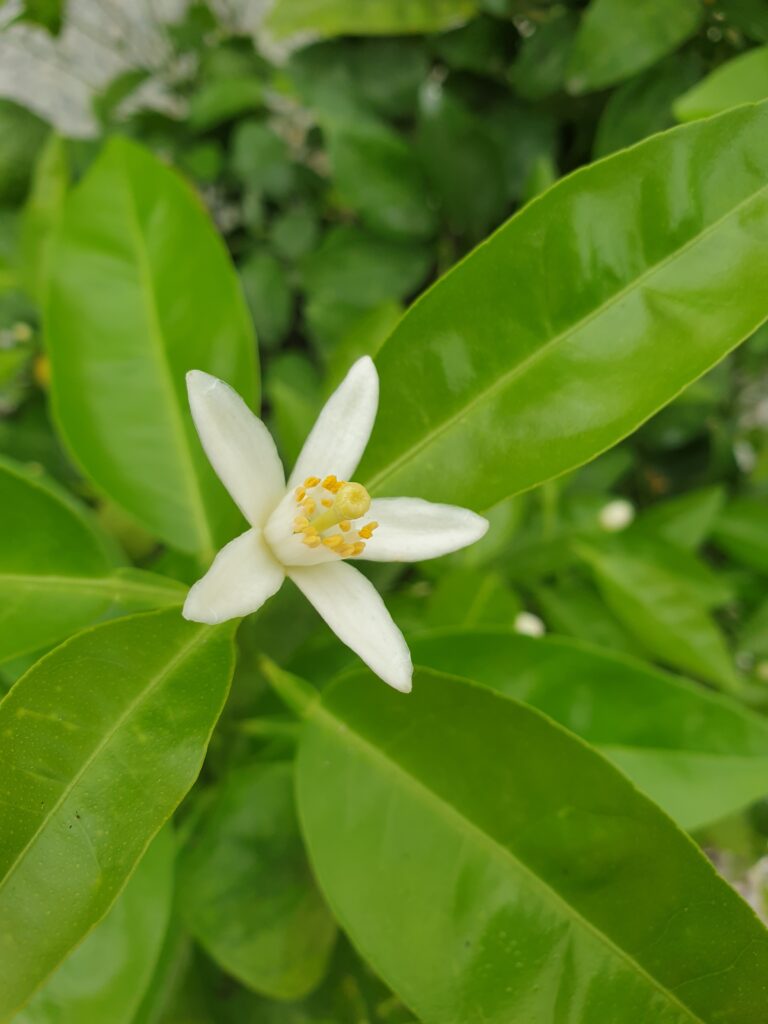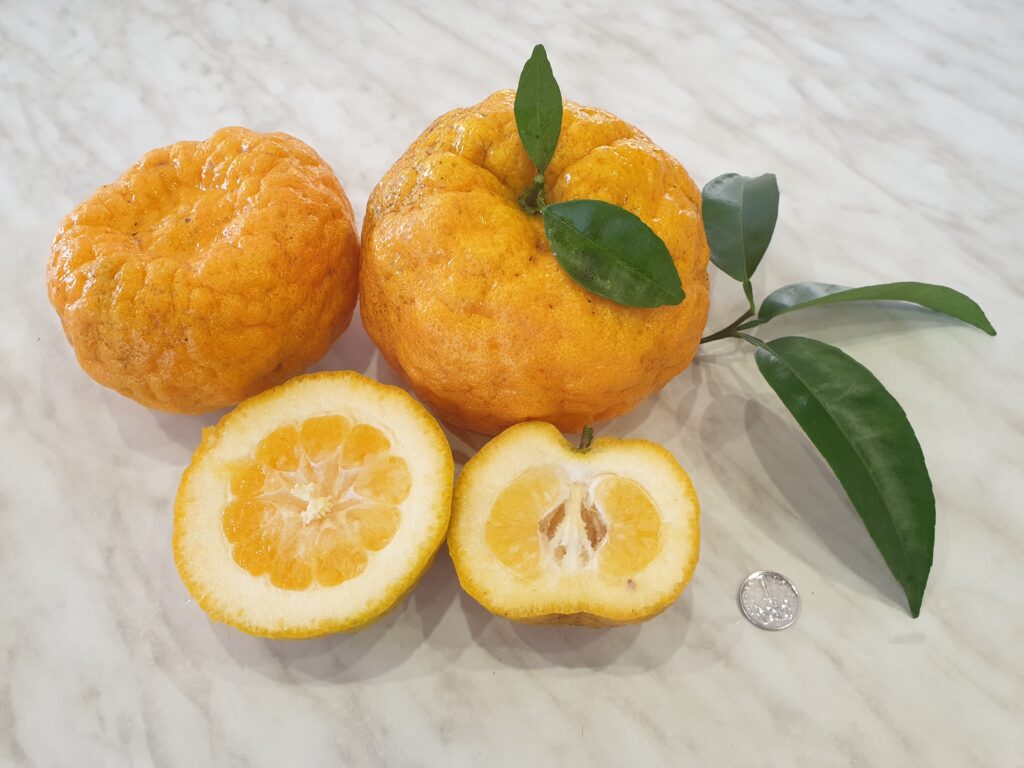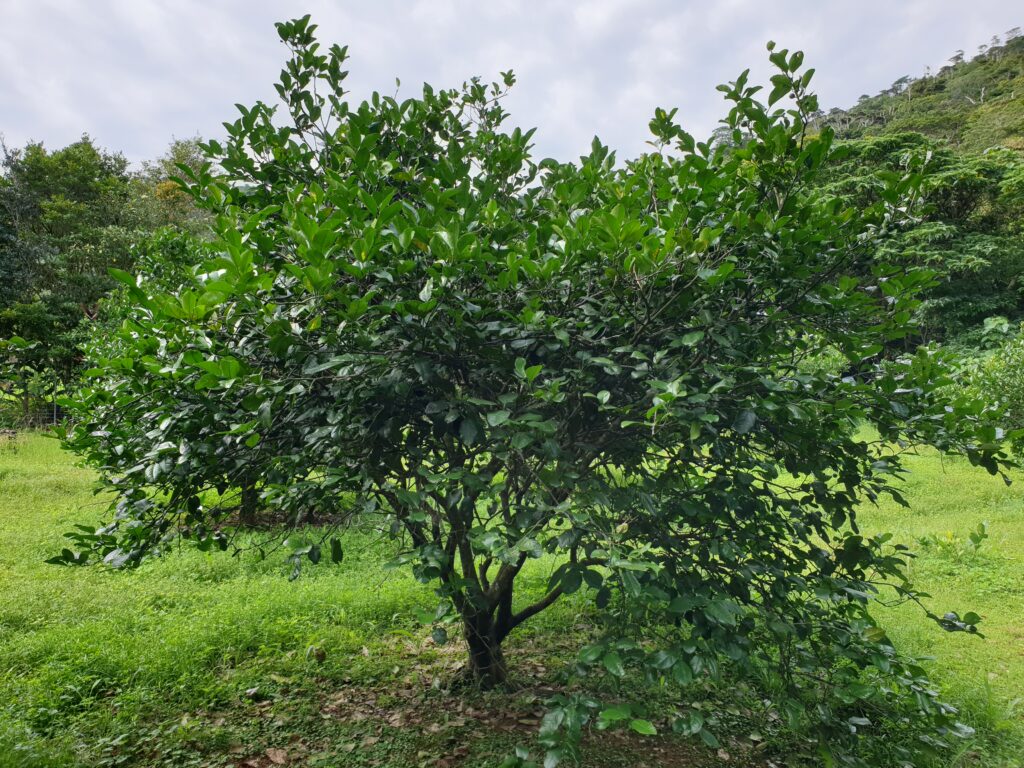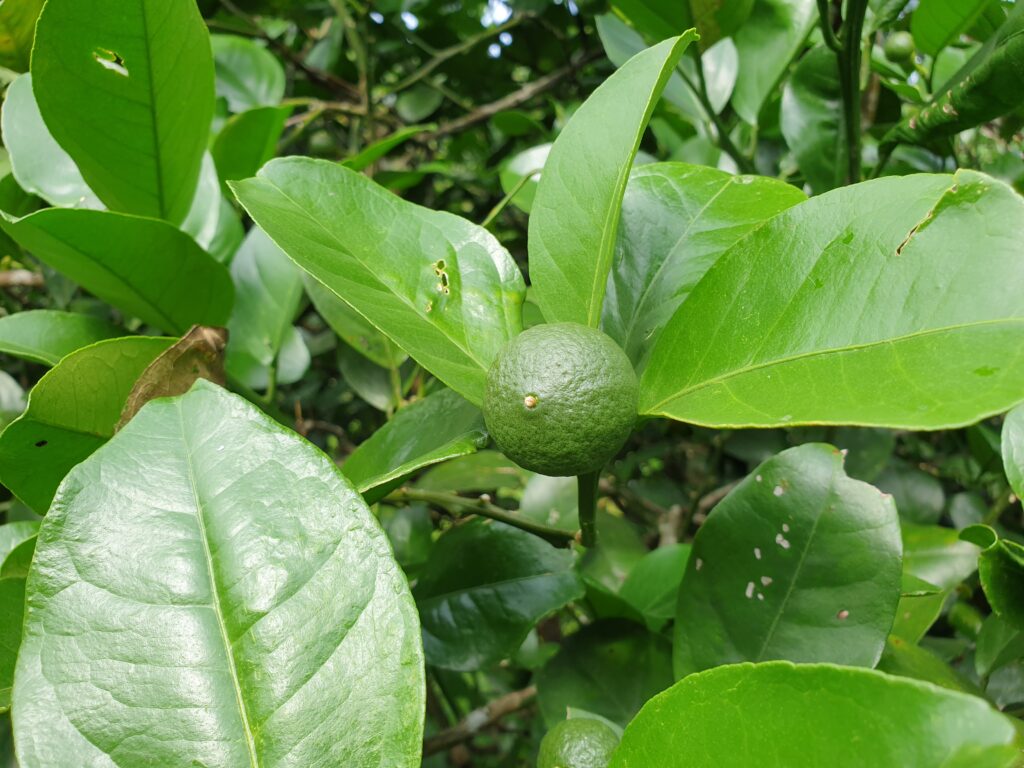In the USA this mandarin is known as King of Siam, often abbreviated as King or Red King. In Europe, it is often referred to as Geleking or Yellow King, or Indochinese or Cambodian mandarin. On the island of Okinawa it is called Kunibu or also Tookunibu (where Too means Chinese). In Japanese, Kunembo ( 九年母 ) translates as “mother of nine”. The Citrus nobilis Lour. group is very heterogeneous worldwide, with Shimizu (2016) indicating 4 types, each quite possibly of a different origin. The King type, (Citrus nobilis var. nobilis Lour.) was imported to the USA from Vietnam as seeds in 1880 (Morton, 1987). It is a similar cultivar to the European Geleking, but a different variation than the Kunembo type in Okinawa. Citrus nobilis is native to Indo-China, from where it spread north to Japan and south throughout Malaysia. Many mandarins currently found in the Malay region and a few in China have their origin in C. nobilis (Hodgson, 1967).
Citrus nobilis Lour.‘Geleking’
It was originally known as Cam Sang when it was recorded by Chez Deterville as an orange tree growing in Tonkin (at that time the name was given to the region of French Indochina, i.e. Cambodia, Laos and Vietnam). It was supposed to be the most common type of orange in the area. The name ‘Cambodian orange’ was given in 1895 Bulletin du Muséum in the study Guillaumina: Mandarine, King of Siam, Orange du Cambodge. In 1899, the Annamite-French Dictionary gives the name of the Cambodian orange slightly differently as ‘Cam Sanh’ (Leroux, 1899). The term Sành, ‘terracotta’, could be based on the fact that the flesh is often reddish in colour. When the seeds were imported into the USA, the term Cam Sành was translated as Queen of Siam (Poilane, 1965), which later gave the name King of Siam to the American cultivar, hereafter known only as King.
The main differences from the Kunembo are the larger fruit size which easily exceeds 80mm, averaging 275g in Vietnam (it is one of the largest mandarins) and the thicker bumpy skin compared to the thinner and smoother skin of the Kunembo and the shorter cut white seeds with weaker beaks. King also has a less bitter taste.
Geleking ripens in Europe in December-January and the fruit is usually slightly smaller than in the country of origin. They can remain on the tree for a long time, allowing them to be eaten gradually. They are flattened but have less juice. The thick skin discolours with time and peels easily. In the country of origin in warm climates, however, the fruit usually remains green or shows only slight discolouration. The fruit is strongly influenced by environmental factors, including the rootstock and the soil, so the shape, size and flavour of the fruit can vary considerably, even depending on the weather at the time of ripening. Geleking requires high temperatures for good flavour.
In addition to consuming fresh fruits, orange cider is made from them in Vietnam by fermenting the juice (Tuyền, 2022).
The cold resistance is lower than that of Satsumas, i.e. about -7°C. From a climatic point of view, the most characteristic feature of Citrus nobilis Lour. is the high heat requirement to reach fruit maturity and good quality, making it the latest ripening species of mandarin. The fruit is also strongly influenced by environmental factors, including the rootstock and the soil. On some rootstocks and light soils, the surface of the skin is warty and the flavour is bland. The plant has an acceptable flavour under optimum conditions and in the warmest climates (UCR, 2024).



Citrus nobilis Lour. var. kunep Tanaka ‘Kunembo’
The Okinawan Kunembo carries a proportion of the genetic code of the Chinese mandarin Citrus reticulata (Blanco), the pomelo Citrus maxima (Burm.) with a small admixture of the wild mandarin Manshanyeju. It is also a pollen descendant of Kishu mandarin (Citrus kinokuni hort. ex Tanaka) (Wu, 2021). The proportion of pomelo is significantly higher in Kunembo than in the King variant (Pang, 2003), while that of Manshanyeju mandarin is lower and the two variants are not closely related. However, neither are tangor as previously reported and neither are descended from orange (Wu, 2021).
Kunembo-mikan was introduced to Ryukyu from Indochina sometime between the 8th and 12th centuries (Shimizu, 2018). Although not native, it is one of the oldest mandarins that subsequently spread to what was then Japan. There, it gave rise to many other hybrids, including its descendants Satsuma, Kabosu, Hyoukan, Hassaku and Asahikan (Shimizu, 2022).
Kunembo was one of Okinawa’s main products, but after an export embargo was imposed in 1919, production plummeted, and after the ban on citrus exports was lifted in 1982, the much sweeter Satsuma mandarins and Tankan tangors were grown. Today, only a few trees remain in various parts of Okinawa and the fruit is used for traditional confectionery, kippan (candied peel) and marmalades, which also use the aromatic peel. Kunembo is rich in juice, has a high sugar content, is often eaten raw for its rich flavour and is said to be eaten by children instead of sweets (Orion Breweries, 2023).
The skin of the mandarin is thick (especially for a mandarin), difficult to peel, has a specific aroma (pine resin, turpentine), the surface is medium smooth to rough. At maturity, the colour is deep yellow-orange to orange. Fruit size is around 180 g. The tree is medium-sized. The leaves are usually larger and wider than those of Satsuma mandarins, with small wings. There are no thorns. The flowers are usually single and rarely form inflorescences (J-FEC, 2024-2)
Kunembo’s main importance is not in its uses or its role in Japanese culture, but Kunembo is one of the ancestors of much of Japan’s citrus fruit, including those in Okinawa (Wakana, 2011). The naming of the nine-year-old mother is therefore more than symbolic. In the past, it was the main type of mandarin in Okinawa along with ‘Oto‘ and others, but due to aging trees and typhoon damage, cultivation has been greatly reduced (Orion Breweries, 2023).



Ogimi
